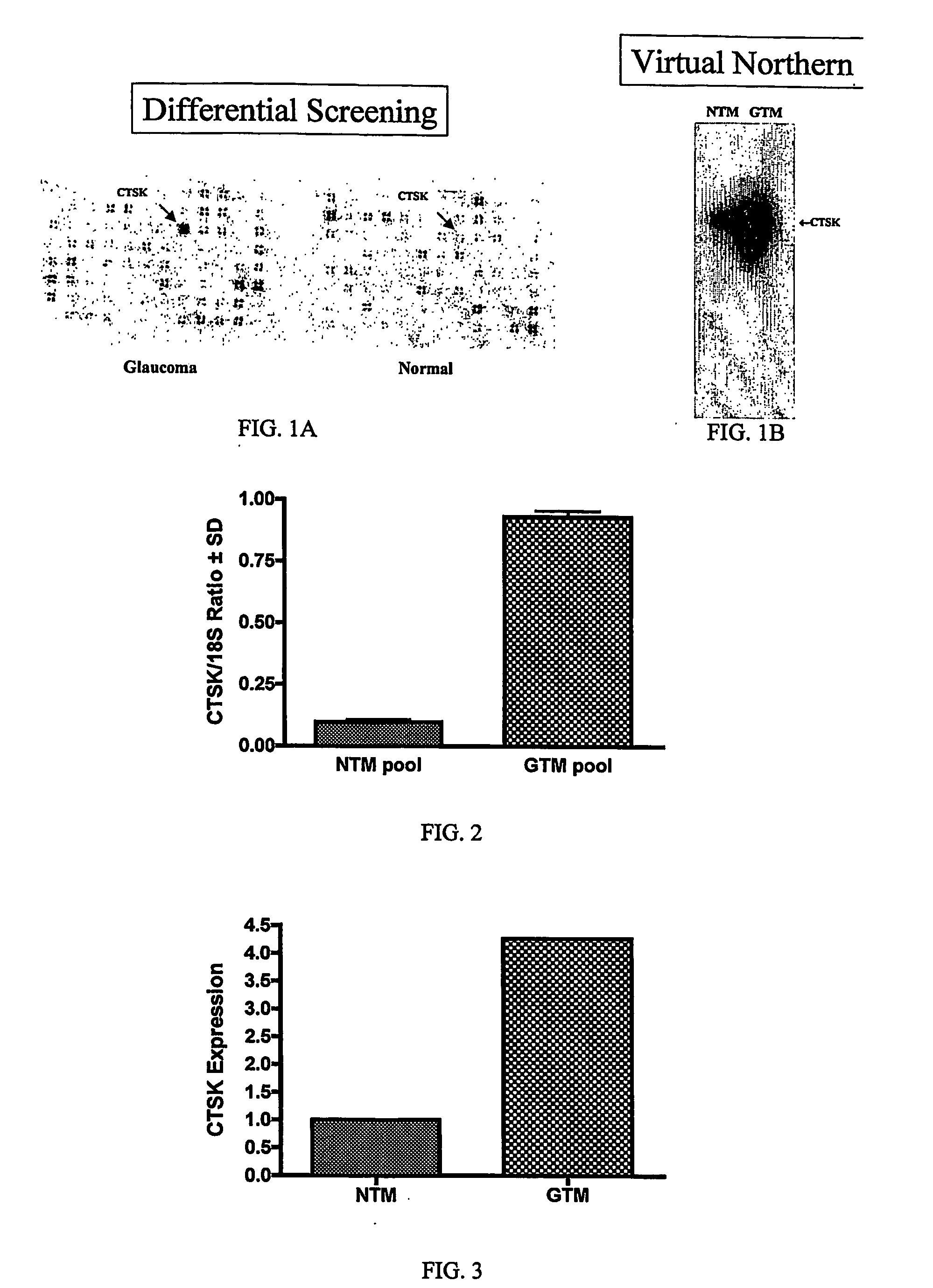Use of cathepsin k inhibitors for the treatment of glaucoma
a technology of cathepsin k and glaucoma, which is applied in the field of glaucoma treatment, can solve the problems of iop elevation, loss of retinal ganglion cells (rgc) and axons, and high so as to improve the retention of the formulation in the conjunctival sac, reduce the risk of visual loss, and dissolve the compound
- Summary
- Abstract
- Description
- Claims
- Application Information
AI Technical Summary
Benefits of technology
Problems solved by technology
Method used
Image
Examples
example 1
cDNA Subtraction Screen & Virtual Northern Blot Analysis
[0170] CTSK was originally identified in a custom PCR-Select cDNA subtraction screen (Clontech, Palo Alto, Calif.) as being more abundant in glaucomatous than normal TM cells. Human TM cells were derived from donor eyes (Central Florida Lions Eye and Tissue Bank, Tampa, Fla.) and cultured as previously described (Steely, Browder et al. 1992; Wilson, McCartney et al. 1993; Clark, Wilson et al. 1994; Dickerson, Steely et al. 1998; Wang, McNatt et al. 2001).
[0171] The cDNA subtraction procedure was essentially performed as follows. Total RNA (700 μg) was isolated from pooled normal (NTM10C, NTM69C, NTM96, NTM57C, NTM53A, NTM95, and NTM93) or glaucomatous TM cell lines (GTM999, GTM59B, GTM19, GTM62, GTM29, and GTM86) as described by Shepard et al. (2001). Poly A+ RNA was subsequently isolated from the total RNA by two rounds of selection with oligo-dT latex beads using a Nucleotrap mRNA Midi kit (Clontech, Palo Alto, Calif.). PCR...
example 2
Quantitative PCR
[0173] Additional verification of differential expression of CTSK was performed by Quantitative Real-Time PCR (QPCR). First strand cDNA was generated from 1 μg of total RNA isolated from pooled normal or glaucoma TM cell lines (identical to those used in the cDNA Subtraction analysis) using random hexamers and Taqman Reverse Transcription reagents according to the manufacturer's instructions (Applied Biosystems, Foster City, Calif.).
[0174] Measurement of CTSK gene expression by QPCR was performed using an ABI Prism 7700 Sequence Detection System (Applied Biosystems, Foster City, Calif.) essentially as described (Shepard et al. 2001). Primers for CTSK QPCR amplification were based on the sequence information in GenBank accession # NM—000396 and were designed using Primer Express software (Applied Biosystems, Foster City, Calif.). Forward and reverse primer sequences were CATATGTGGGACAGGAAGAGAGTTG (nucleotides 734-758) and GGATCTCTCTGTACCCTCTGCATT (nucleotides 788-81...
example 3
Affymetrix GeneChip Analysis
[0175] In addition to the identification of CTSK by cDNA subtraction analysis, CTSK was subsequently identified as upregulated in GTM cells by Affymetrix GeneChip (Affymetrix, Santa Clara, Calif.) analysis using pooled normal (NTM94, NTM68B, NTM79B, and NTM55C) or glaucomatous TM cells (GTM19A, GTM54A, GTM62E&G, and SGTM152) (NTM=normal trabecular meshwork; GTM=glaucomatous trabecular meshwork). Essentially, total RNA was collected from the cell lines using TRIZOL reagent according to the manufacturers instructions (Invitrogen, Carlsbad, Calif.), pooled, and subjected to reverse transcription, in vitro transcription, and biotin-labeling of amplified cRNA according to standard Affymetrix protocols (Affymetrix, Santa Clara, Calif.). The Affymetrix Human Genome U133A / B GeneChip (Affymetrix, Santa Clara, Calif.) set was probed with labeled cRNA from either the normal or glaucoma TM cells. Hybridized GeneChips were scanned with a GeneArray scanner (Agilent Te...
PUM
| Property | Measurement | Unit |
|---|---|---|
| volume | aaaaa | aaaaa |
| intraocular pressure | aaaaa | aaaaa |
| tension | aaaaa | aaaaa |
Abstract
Description
Claims
Application Information
 Login to View More
Login to View More - R&D
- Intellectual Property
- Life Sciences
- Materials
- Tech Scout
- Unparalleled Data Quality
- Higher Quality Content
- 60% Fewer Hallucinations
Browse by: Latest US Patents, China's latest patents, Technical Efficacy Thesaurus, Application Domain, Technology Topic, Popular Technical Reports.
© 2025 PatSnap. All rights reserved.Legal|Privacy policy|Modern Slavery Act Transparency Statement|Sitemap|About US| Contact US: help@patsnap.com

